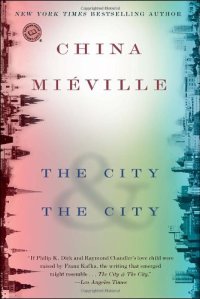“The City & the City” by China Miéville
 The City & The City is the third China Miéville book that I’ve read, each different genres. Perdido Street Station was a steampunk/fantasy, Embassytown was science-fiction, and The City & The City is a police procedural. Each of them is pretty uniquely Miéville, though – his imagination is incomparable, and I love how he dabbles in different genres and manages to retain his voice.
The City & The City is the third China Miéville book that I’ve read, each different genres. Perdido Street Station was a steampunk/fantasy, Embassytown was science-fiction, and The City & The City is a police procedural. Each of them is pretty uniquely Miéville, though – his imagination is incomparable, and I love how he dabbles in different genres and manages to retain his voice.
As I mentioned, The City & The City is a detective story, somewhat noir inspired. However, it’s set in the city-states of Besźel and Ul Qoma, somewhere on the edge of Europe. Besźel and Ul Qoma are intertwined cities that are completely independent from each other. The nearest example I can think of is Toll-by-Night and Toll-by-Day in Fly Trap. They are located in the same physical location, but some buildings/streets/locations belong to Besźel and some belong to Ul Qoma. Their culture, language, economic status etc. are very different. Residents of each city are trained to ignore the other city’s sights, sounds and smells. “Unseeing”, “unhearing” etc. are taught to children from a young age. If they break these laws, a shadowy force called Breach descends upon them, and they are never seen again. Tourists and children are allowed some leeway (tourists are deported.)
In this mad world (which is part of our own modern day world), Inspector Tyodor Borlú of the Besźel Extreme Crimes Unit discovers a corpse of a dead woman. However, she turns out to be from Ul Qoma, and seems to have made enemies among powerful people in both cities while investigating the legend of the mysterious, all-controlling third city, Orciny. Borlú can’t resist the mystery and goes above and beyond his duties to investigate this murder.
The worldbuilding in this story is absolutely fantastic. I find it utterly implausible that humans in our current world would put up with the absurd constraints of these two cities, but even so, the world is very well-thought out. I would have expected to have a lot of questions about how the logistics of this worked, but Miéville has laid out a very detailed (and very bureaucratic) world. And of course, there are the obvious unificationists, the hardcore nationalists, the conspiracy theorists, etc. Miéville mentions the myths surrounding the formation of Besźel and Ul Qoma many times, but never actually explains it. I wish that these cities were set on an alien planet (Bas-Lag from his other books, maybe?) or something, the familiarity of our world (email, planes, American embassies) made the cities really jarring.
The murder mystery and the conspiracy were well-thought out and written (although I did suspect the murderer), and I was pretty surprised by some of the revelations (in a “I should’ve seen that! How clever!” way.) I enjoyed the characters, although they seemed to be stock police types from TV shows (with much more profanity.) As usual, it’s hard to empathise with Miéville’s characters – I read the book for the ideas.
I’m still not sure if this book had any fantasy elements – they are hinted at, but I don’t think they were ever made explicit.
The ending of the book left me a bit annoyed and confused – I thought it was a bit of a letdown after the strength of the rest of the book. I don’t want to say more about it, but that’s probably the main reason that I didn’t absolutely love this book.
—
This is book 19 of 25 of my Dec 11, 2011 book challenge.

Pingback: Books I plan to read soon. « Kriti Godey
I cannot read this review as I’m still reading this book!
I try to keep my reviews spoiler free, but I definitely understand! :)
Pingback: “The Scar” by China Miéville | Kriti Godey